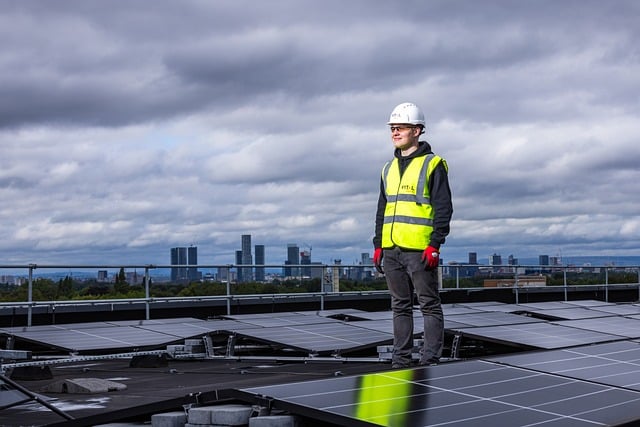“Weather Matters: Unlocking Solar Performance Insights Through Climate Awareness.”
The impact of weather on solar performance monitoring is a critical aspect of optimizing solar energy systems. Weather conditions, including sunlight intensity, temperature, humidity, and atmospheric phenomena, significantly influence the efficiency and output of solar panels. Variations in these factors can lead to fluctuations in energy production, making it essential to monitor and analyze weather data alongside solar performance metrics. Understanding the interplay between weather and solar energy generation enables better forecasting, system design, and maintenance strategies, ultimately enhancing the reliability and effectiveness of solar power systems. This introduction highlights the importance of integrating meteorological insights into solar performance monitoring to maximize energy yield and improve overall system performance.
Weather Variability and Its Effects on Solar Energy Output
Weather variability plays a crucial role in determining the performance of solar energy systems, influencing both their efficiency and overall energy output. Solar panels rely on sunlight to generate electricity, and any fluctuations in weather conditions can significantly impact their effectiveness. For instance, cloudy days can reduce the amount of direct sunlight that reaches solar panels, leading to decreased energy production. This phenomenon is particularly pronounced in regions that experience frequent overcast conditions, where solar energy systems may underperform compared to sunnier locales.
Moreover, the angle and intensity of sunlight are critical factors in solar energy generation. During the winter months, when the sun is lower in the sky, solar panels may receive less direct sunlight, further diminishing their output. Additionally, seasonal variations can lead to significant differences in energy production. For example, summer months typically yield higher solar energy output due to longer daylight hours and more intense sunlight, while winter months may see a decline in performance. This seasonal variability necessitates careful planning and monitoring to optimize energy production throughout the year.
Rain and precipitation also contribute to the variability in solar energy output. While rain can help clean solar panels, removing dust and debris that may obstruct sunlight, it can also lead to periods of reduced energy generation. In regions where rain is frequent, solar energy systems may need to be designed with this variability in mind, incorporating larger arrays or battery storage solutions to compensate for potential dips in output. Furthermore, the impact of snow accumulation on solar panels cannot be overlooked. In colder climates, snow can cover panels, blocking sunlight and significantly reducing energy production until it melts or is cleared away.
Temperature is another critical factor influencing solar performance. Solar panels operate more efficiently at cooler temperatures; however, extreme heat can lead to a decrease in efficiency. As temperatures rise, the electrical resistance within the panels increases, which can reduce their overall output. This relationship highlights the importance of considering local climate conditions when designing and installing solar energy systems. In areas with high temperatures, it may be beneficial to implement cooling strategies or select panels specifically designed to perform better under such conditions.
Wind can also affect solar energy output, albeit indirectly. High winds can lead to increased cooling of solar panels, which may enhance their efficiency. However, strong winds can also pose a risk to the structural integrity of solar installations, particularly if they are not properly secured. Therefore, understanding local wind patterns is essential for ensuring the longevity and reliability of solar energy systems.
In conclusion, the impact of weather variability on solar energy output is multifaceted and requires careful consideration during the planning and monitoring phases of solar energy projects. By understanding how different weather conditions affect solar performance, stakeholders can make informed decisions regarding system design, installation, and maintenance. This knowledge not only helps optimize energy production but also enhances the overall reliability and sustainability of solar energy systems. As the demand for renewable energy continues to grow, recognizing and adapting to the effects of weather variability will be essential for maximizing the potential of solar energy in diverse environments.
The Role of Temperature in Solar Panel Efficiency

The efficiency of solar panels is significantly influenced by various environmental factors, with temperature being one of the most critical elements. As solar technology continues to advance, understanding the relationship between temperature and solar panel performance becomes increasingly essential for optimizing energy production. Solar panels are designed to convert sunlight into electricity, but their efficiency can fluctuate based on the ambient temperature. Generally, solar panels operate more efficiently in cooler conditions; however, this does not mean that they perform poorly in warmer climates. Instead, the performance of solar panels is a complex interplay between temperature, sunlight intensity, and other environmental factors.
When temperatures rise, the efficiency of solar panels tends to decrease. This phenomenon occurs because most solar cells are made from semiconductor materials, which exhibit a decrease in voltage output as temperatures increase. Specifically, for every degree Celsius that the temperature rises above a certain threshold, the voltage output of the solar panel can drop by approximately 0.2%. Consequently, in regions where high temperatures are prevalent, solar panel performance can be adversely affected, leading to lower energy yields. This is particularly important for solar energy systems in areas with extreme heat, where the potential for energy loss can be substantial.
Moreover, the impact of temperature on solar panel efficiency is not uniform across all types of solar technologies. For instance, monocrystalline solar panels typically exhibit better performance in high-temperature conditions compared to their polycrystalline counterparts. This difference arises from the distinct manufacturing processes and material properties of these panels. As a result, when selecting solar panels for installation, it is crucial to consider the local climate and temperature patterns to ensure optimal performance and energy production.
In addition to the direct effects of temperature on solar panel efficiency, it is essential to consider how temperature variations can influence the overall performance monitoring of solar energy systems. Accurate monitoring systems are vital for assessing the health and efficiency of solar installations. However, if temperature data is not adequately integrated into performance monitoring systems, it can lead to misinterpretations of energy output. For instance, a drop in energy production may be mistakenly attributed to panel degradation rather than the effects of elevated temperatures. Therefore, incorporating temperature data into performance monitoring systems allows for a more comprehensive understanding of solar panel efficiency and helps identify potential issues more accurately.
Furthermore, the role of temperature extends beyond just the solar panels themselves; it also affects other components of the solar energy system, such as inverters and batteries. Inverters, which convert the direct current generated by solar panels into alternating current for use in homes and businesses, can also experience efficiency losses at high temperatures. Similarly, battery performance can degrade in extreme heat, impacting the overall energy storage capabilities of a solar energy system. Thus, understanding the thermal dynamics of the entire system is crucial for maximizing energy production and ensuring longevity.
In conclusion, temperature plays a pivotal role in determining the efficiency of solar panels and the overall performance of solar energy systems. As the demand for renewable energy sources continues to grow, it is imperative for solar energy stakeholders to consider temperature effects when designing, installing, and monitoring solar installations. By doing so, they can enhance energy production, optimize system performance, and ultimately contribute to a more sustainable energy future.
Cloud Cover and Its Influence on Solar Performance Metrics
Cloud cover plays a significant role in determining the performance of solar energy systems, influencing both the efficiency of solar panels and the overall energy output. As solar technology continues to advance, understanding the nuances of how varying cloud conditions affect solar performance metrics becomes increasingly important for optimizing energy production and ensuring the reliability of solar installations. When clouds obscure the sun, they can significantly reduce the amount of solar radiation that reaches the panels, which in turn affects the energy generated. This reduction is not uniform; rather, it varies depending on the type and thickness of the cloud cover. For instance, thin, high-altitude cirrus clouds may allow some sunlight to penetrate, resulting in only a modest decrease in energy output. In contrast, thick, low-lying stratus clouds can block sunlight more effectively, leading to a more pronounced drop in solar performance.
Moreover, the impact of cloud cover is not merely a matter of reduced sunlight; it also introduces variability in solar energy production. This variability can complicate performance monitoring and forecasting, as solar energy systems may experience sudden fluctuations in output due to changing weather conditions. For solar operators and energy managers, understanding these fluctuations is crucial for effective grid management and energy distribution. Consequently, accurate weather forecasting and real-time monitoring of cloud cover become essential tools in the solar industry. By integrating advanced meteorological data into performance monitoring systems, operators can better anticipate changes in energy production and adjust their strategies accordingly.
In addition to immediate impacts on energy output, cloud cover can also influence long-term performance metrics. For example, prolonged periods of overcast weather can lead to a decrease in the overall energy yield of a solar installation over time. This is particularly relevant in regions where cloud cover is frequent, as it can affect the return on investment for solar projects. Therefore, understanding the local climate and typical cloud patterns is vital for stakeholders when assessing the viability of solar energy systems in specific locations. Furthermore, the design and orientation of solar panels can be optimized based on local weather patterns, allowing for improved performance even under less-than-ideal conditions.
Another important aspect to consider is the role of cloud cover in the context of solar tracking systems. These systems are designed to follow the sun’s path throughout the day, maximizing exposure to sunlight. However, during cloudy days, the effectiveness of tracking systems may diminish, as the diffuse light from clouds does not provide the same intensity as direct sunlight. This can lead to a reevaluation of the cost-effectiveness of such systems in areas with frequent cloud cover. As a result, solar performance monitoring must take into account not only the presence of clouds but also their type and movement, allowing for a more nuanced understanding of how they affect energy production.
In conclusion, cloud cover significantly influences solar performance metrics, impacting both immediate energy output and long-term efficiency. By recognizing the complexities introduced by varying cloud conditions, solar operators can enhance their performance monitoring strategies, optimize system design, and ultimately improve the reliability and profitability of solar energy systems. As the industry continues to evolve, the integration of advanced weather data and monitoring technologies will be essential in navigating the challenges posed by cloud cover, ensuring that solar energy remains a viable and sustainable energy source.
Seasonal Weather Patterns and Their Impact on Solar Monitoring Systems
Seasonal weather patterns play a crucial role in the performance of solar energy systems, significantly influencing the efficiency and effectiveness of solar monitoring systems. Understanding these patterns is essential for optimizing solar energy production and ensuring that monitoring systems provide accurate data. As solar panels rely heavily on sunlight for energy generation, variations in weather conditions throughout the year can lead to fluctuations in energy output. For instance, during the summer months, when days are longer and sunlight is more intense, solar panels typically operate at peak efficiency. Conversely, winter months may bring shorter days and increased cloud cover, resulting in reduced energy production.
Moreover, the impact of seasonal weather patterns extends beyond mere sunlight availability. Rain and snow can also affect solar performance. While rain can help clean solar panels, enhancing their efficiency, heavy snowfall can obstruct sunlight and lead to significant energy losses. In regions where snow accumulation is common, monitoring systems must account for these conditions to provide accurate assessments of solar performance. This necessitates the integration of weather data into monitoring systems, allowing for real-time adjustments and predictions based on current conditions.
In addition to precipitation, temperature variations throughout the seasons can also influence solar panel performance. Solar panels generally operate more efficiently at lower temperatures, as excessive heat can lead to decreased energy output. Therefore, monitoring systems must not only track sunlight exposure but also temperature fluctuations to provide a comprehensive view of solar performance. By analyzing this data, operators can identify trends and make informed decisions regarding maintenance and operational adjustments.
Furthermore, seasonal weather patterns can lead to the need for more sophisticated monitoring technologies. For example, in areas prone to extreme weather events such as hurricanes or heavy storms, solar monitoring systems must be equipped to withstand these conditions. This may involve the use of advanced materials and designs that enhance durability and resilience. Additionally, the integration of predictive analytics can help operators anticipate potential weather-related disruptions, allowing for proactive measures to mitigate risks.
As solar energy continues to gain traction as a sustainable energy source, the importance of understanding seasonal weather patterns cannot be overstated. Effective solar monitoring systems must be designed to adapt to these variations, ensuring that they provide accurate and timely data. This adaptability is crucial for maximizing energy production and minimizing downtime, ultimately contributing to the overall efficiency of solar energy systems.
Moreover, the relationship between weather patterns and solar performance monitoring extends to the broader context of energy management. By leveraging weather data, operators can optimize energy storage solutions, ensuring that excess energy generated during peak sunlight hours is effectively stored for use during less favorable conditions. This not only enhances the reliability of solar energy systems but also contributes to a more stable energy grid.
In conclusion, the impact of seasonal weather patterns on solar performance monitoring is multifaceted and significant. By understanding and integrating these patterns into monitoring systems, operators can enhance the efficiency and reliability of solar energy production. As the demand for renewable energy continues to grow, the ability to accurately monitor and respond to weather-related challenges will be paramount in ensuring the long-term success of solar energy initiatives.
Q&A
1. **Question:** How does cloud cover affect solar panel performance?
**Answer:** Cloud cover reduces the amount of direct sunlight reaching solar panels, leading to decreased energy production, typically by 10-25% depending on the density of the clouds.
2. **Question:** What is the impact of temperature on solar panel efficiency?
**Answer:** Higher temperatures can decrease the efficiency of solar panels, as most photovoltaic cells perform optimally at cooler temperatures, with efficiency dropping by about 0.5% for every degree Celsius above 25°C.
3. **Question:** How does snow accumulation influence solar energy generation?
**Answer:** Snow accumulation can block sunlight from reaching solar panels, significantly reducing energy output; however, panels are often designed to shed snow due to their angle and surface properties.
4. **Question:** In what way does humidity affect solar performance?
**Answer:** High humidity can lead to increased atmospheric scattering of sunlight, which may slightly enhance diffuse light conditions, but excessive humidity can also cause condensation and potential damage to solar equipment.
Conclusion
The impact of weather on solar performance monitoring is significant, as various atmospheric conditions such as temperature, cloud cover, humidity, and precipitation can directly influence the efficiency and output of solar energy systems. Understanding these weather-related factors is crucial for accurate performance assessment, optimization of energy production, and effective maintenance strategies. Consequently, integrating weather data into solar performance monitoring can enhance predictive analytics, improve system reliability, and ultimately lead to more efficient energy management and utilization.




